United States and United Nations Forces in Bolt Action Korea
by Tom Burgess
Warlord Games has released and within it, forces from the United States and United Nations figure prominently. Warlord has managed to pack a tremendous variety of platoon options all using the United States generic reinforced platoon list as the baseline.
This is appropriate as so many of the United Nations countries that committed troops to the Korean effort were from armies that had largely been rebuilt and reequipped following World War II by the United States. Accordingly, many of these nations’ armies looked a lot like the US Army’s formations.
In addition to the generic reinforce platoon list, the United States and United Nations player can utilize period selectors that more accurately represent these forces at various stages of the war. This is important because these forces elevated heavily from the initial unprepared, poorly equipped, and undermanned type units that the US rushed to Korean Peninsula to try to stem the initial North Korean push south.

The basic US/UN reinforced platoon is organized as follows:
1 Lieutenant – First or Second
2 Infantry squads
plus:
0–3 Infantry squads
0–1 Captain or Major
0–1 Medic
0–1 Forward Observer (either Artillery or Air)
0–1 Machine gun team
0–1 Mortar team
0–1 Flamethrower team
0–1 Sniper Team
0–1 Anti-tank team
0–1 Field Artillery, Anti-aircraft, or Anti-tank gun
0–1 Tank, Tank Destroyer, Anti-aircraft vehicle, or Self-propelled Artillery
0–1 Transport vehicle or tow (soft skins or armored) per infantry and artillery unit in the reinforced platoon
These are very similar to the options WW2 US players will already be familiar with. These units have the same WW2 US special rules that include: Fire and maneuver, Gyro Stabilizers, and Modern Communications. To these two new US special rules are added: Helicopters and KATUSA (Language Barrier).
Helicopters were introduced for the scale during the Korean war, but they had not progressed far enough to be reliable attack platforms. Instead, they were employed for scouting, aerial observation, and casualty evacuation. A helicopter can only be used in the “mid-war” to “late war” period selector lists. They are taken as an upgrade to an Air Observer in one of three versions:
Reconnaissance: 30 points for two uses. When the Air Observer is given an order dice roll a D6: on a 5+, roll a die for each Hidden enemy unit. On a 4+ the unit is spotted and immediately loses the Hidden status and counter.
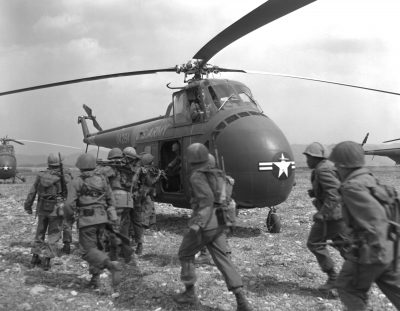
Aerial Observation: 40 points for two uses. When the Air Observer is given an order dice roll a D6: on a 5+, For the duration of the turn, all spotters and Artillery observers count as having line of sight to any unit on the table.
Medevac: 20 points for two uses. When the Air Observer is given an order dice roll a D6: on a 4+, For the duration of the turn, the range of all medics’ special ability is increased from 6” to 18”.
As you can see the “Helicopter” really just enhances onboard unit abilities a couple of times in each game. There really is no need to actually use a helicopter model as its an “effect” more than anything else. However, the rules do recommend that you use a helicopter models and frequent use of “whop, whop, whop” noises. I know I will.
The new KATSUA rule is very interesting. To help bulk out the depleted ranks of the initial US forces hastily sent to the Korean conflict, new South Korean recruits were merged into US infantry platoons. These were known as Korean Augmentees to the US Army or KATUSA. A US squad can generally add up to three rifle-armed KATUSAs for free. However, for each KATUSA taken the squad starts the game with a pin counter on it to represent the relatively untrained KATUSA and the language barrier the squad had to cope with.
The US/UN squads mostly have the same small arms that the US Army WW2 lists had; M1911 Pistol, Thompson SMGs or M3 “Grease Guns”, BARs, M1919 LMGs, and of course the M1 Garand Rifle. The first “new” piece of kit the US infantry can take is the 3.5” Bazooka which is a significant improvement over the WW2 2.36” M9A! Bazooka.
Support weapons such as LMGs, MMGs, HMGs, Medium Mortars, and Heavy Mortars are the same as were available in WW2. Light, Medium, and Heavy Howitzers are also the same as in WW2 as is the 57mm, 3”, and 90mm Anti-Tank Guns. The 57mm and 75mm Recoilless Rifles that were introduced in late in WW2 are available to all US/UN lists.
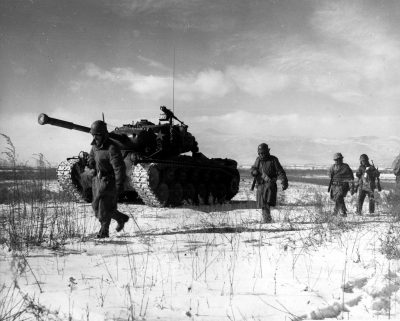
Tank options for the reinforcement platoons include the M24 Chaffee, M4 Sherman in 75mm, 76mm, and 105mm versions, and the Pershing heavy tank from the WW2 arsenal. What is new is the M-45 (T26E2) 105mm Howitzer mounted on a heavy tank and the M46 Patton which for all practical purposes has the exact same characteristics and costs as the M26 Pershing.
Tank Destroyers, Armored Cars, Self-propelled Artillery, and Antiaircraft Artillery options are also abundant, with a few new upgrades. The M5 Half-tack and LVTs are still transport options but to these are added new fully tracked transports such as the M75 Armored Personnel Carrier and the M39(T41) Armored Utility Vehicle.
But what about the United Nations allied forces? Those are more accurately covered in the Period Selector section rather than in the generic reinforced platoon lists. The selector periods are broken up into the following lists:
- Invasion
- Defense of Pusan/Advance Across the 38th Parallel
- Inchon Landings/Crossing the 38th Parallel
- UN Counteroffensive – Spring 1951
- July 1951
- July 1952
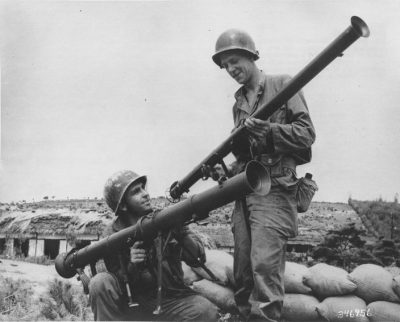
The UN force options (other than South Korean and Commonwealth) include:
- Belgium/Luxembourg: Regular EW, Regular or Veteran MW/LW
- Columbia: Inexperienced EW, Regular or Veteran MW/LW
- Ethiopia: Regular EW, Regular or Veteran MW/LW
- France: Regular, Veteran
- Greece: Regular, Veteran
- Netherlands: Regular, Veteran
- Philippines: Regular, Veteran MW/LW
- Thailand: Inexperienced EW, Regular or Veteran MW/LW
- Turkey: Inexperienced EW, Regular or Veteran MW/LW
These UN forced are a bit more limited in heavy equipment options and they use the following selector lists:
1 Lieutenant – First or Second
2 Infantry squads: Infantry squads
plus:
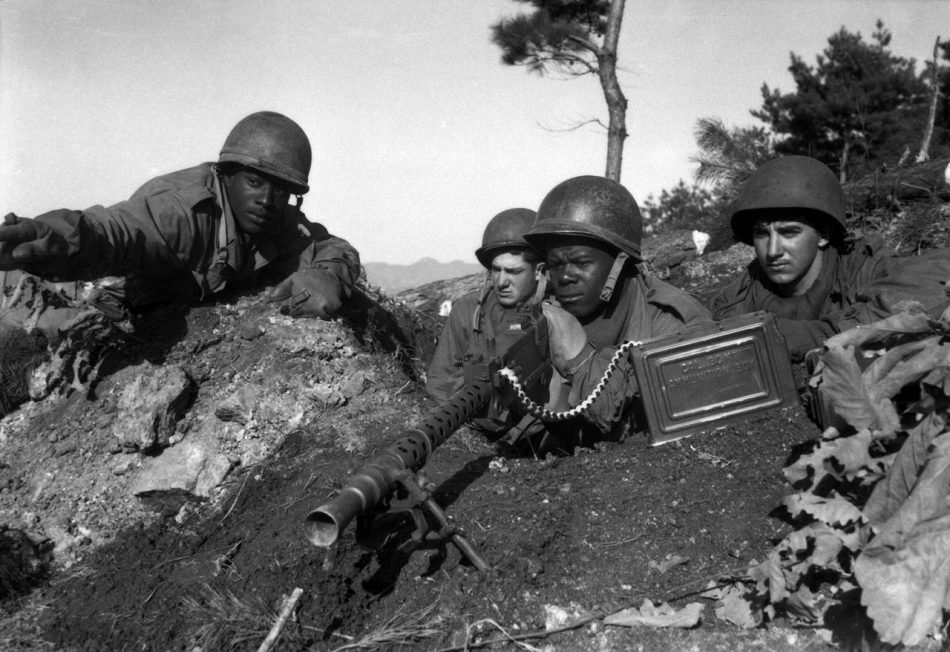
Headquarters
0–1 Captain or Major 0–1 Veteran NCO
0–1 Forward Observer (Artillery- Philippines, Turkey only)
0–1 Medic
Infantry
0–4 Infantry squads, a maximum of 1 engineer squad (Turkey only)
0–1 Machine gun team
0–1 Mortar team: light or medium
0–1 Sniper Team
0–2 Bazooka Teams (M9A1 or M20)
Artillery
- M2A1 (Philippines, Turkey only)
- Recoilless Rifle: 0–1 M18, M20
Armor
0–1 M-24 Chaffee (Philippines Only)
0–1 Transport vehicle or tow per infantry and artillery unit in the reinforced platoon: pack animal, horse-drawn limber, Jeep, Three Quarter ton truck, One-and-a-half-ton truck, Two-and-a-half-ton truck
So there you have it. The US Army, Army Airborne, USMC, and nine other UN forces are very well represented by the options made available by the United States and United Nations generic and period selectors in . Players who already have US WW2 Bolt Action forces will see their collections have great utility in Bolt Action Korea. These will be enhanced by new features like helicopters, KATUSAs, and some new equipment options. This will greatly expand the gaming and enjoyment options for many Bolt Action players for quite some time to come.

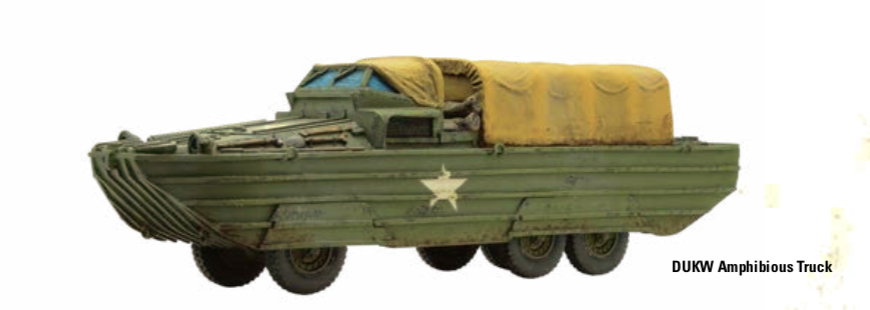
What about the Brits?
Coming soon. Our bench of writers for Bolt Action/Warlord stuff is still growing. The British and Commonwealth actually get their own period selectors in the book.
superb